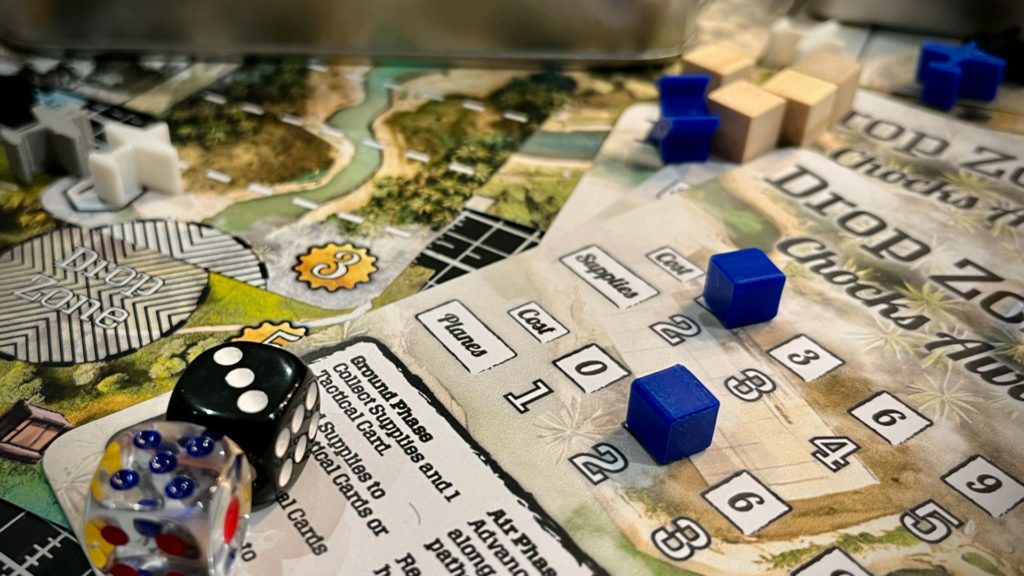In this conversation I catch up with Mikey about his current crowdfunding campaign for his game Kugo. You can find out more about the game here, back it on kickstarter and find Mikey on Instagram.
This is the first of two parts, in this post we talk about where Kugo came from and how Mike got up to the launch. In the next post we’ll find out how the campaign is going and what he’s learned from it so far.
Joe: Let’s start with well done! You’ve done it, the kickstarter is a success, you met the target. How are you feeling?
Mikey: Good, it’s all a bit surreal really. We made it which is great and we’ve got everything we need. We’ve gone from a concept through to a prototype to now it’s a finished thing.
It’s funny, you spend all this time getting up to the Kickstarter moment and you realise it’s just step one and the rest is to come. It’s a weird roller coaster. I go from really excited and then suddenly feeling quite flat. Then you realise there’s loads more to do. You continue bouncing between the highs and lows. Overall it’s been amazing and we’ve been very lucky.
Joe: Would you just give me a short overview of Kugo – where did it come from?
Mikey: The origin story! My boy and I started flicking a bottle top during lockdown and it just snowballed from there. I tried to get him to flick it through a goal, he did that pretty easily. Then we had to rebound it and get into the goal. Each time we upped the ante. It became loads of fun and we giggled and laughed, then we got out the saucepans; it was all a bit mad.
At the time, we had a little workshop next to the house. So I made some ramps out of wood and we started making little components to try out. It was something we enjoyed doing and I figured there must be something like this in the real world because it’s a simple idea. I looked and there wasn’t.
f**k it, let’s give it a go
Mikey
I thought “well f**k it, let’s give it a go” and that was it. We had some of the basic components made and I packaged them into a little box. We took it to a few demos and it got really good feedback. That was it, we just kept going.
It’s a weird one though, Kugo is a game where it’s niche enough in the board game industry that some people don’t really get it. But as soon as people play, you can just see the spark in their eye, suddenly the game clicks for them.
Joe: That’s really cool. I’m looking forward to getting my hands on it. The quality of your game looks great. What’s driven that?
Mikey: Well, a cheesy and honest story is that my grandparents have got a box underneath their stairs. It’s full of games. My aunties and my mum played with it, I played with it as a kid, and now my kids play with it when we visit. This box is full of old toys that have been around for generations. This is what’s driving Kugo – I want something that will be in a grandparent’s house one day with kids playing with it. I like that, that nostalgia, that longevity.
Joe: That’s really, really nice. So why did you press go last Tuesday? What got you to the point where that was the day?
Mikey: Naivety would be the biggie, and impatience, if I’m really honest. We thought we had a finished game about a year ago and were going to press go but then we spoke to a few people and realised we weren’t ready in terms of the numbers needed for a successful campaign.
So we paused and said, “right, we’ll give it a year” to build up the numbers. In that time of waiting, we developed the game further. There’s now loads more to it. I’m glad we didn’t try a year ago. This time we aimed for about a thousand people following us, then we knew we’d be ready.
Joe: When you talk about 1000 people, is that following the Kickstarter launch page, on Instagram, on TikTok, or a thousand people on a mailing list?
Mikey: We wanted 1000 on a mailing list and between 800 and a 1000 on the Kickstarter page. First I was all about Instagram; I put a lot of my time building up an Instagram following and got weirdly squashed halfway through – the numbers just weren’t growing. Then, speaking to people in the industry, they said, forget Instagram, focus on your mailing list and push people to that Kickstarter page.
Joe: In terms of the mailing list, what strategies did you use to build it? Was it paid-for or is that you going out on the streets with the game, getting people to write their email address down?
Mikey: A little bit of both. Getting out there and getting people to organically come through through blog posts, that did pretty well; we got a few hundred. But paid ads were the way forward. We hired a person from YG Crowdfunding. They’re ex-Kickstarter, really reasonable and amazing. We had a budget for marketing. We had a budget for ads. They knew the target we wanted. Easily (and annoyingly) the fastest way of growth was through paid ads without a doubt.
Joe: Ahead of the campaign how much prep work was done? What was ready to go, and what happened on the fly?
Mikey: I’d love to say there was prep work! People talk about scheduling posts and planning content. I just don’t have the time, we have a very busy home life. I was doing most of the promo on the fly. We had several ideas for the week leading up to the launch, which I quickly whipped up into videos and that was the prelaunch campaign.
Joe: You’re using ‘we’ a lot. Who is ‘we’?
Mikey: We is probably 60% me. Anna, my wife, is the other 40%. And then the boys: my seven year old loves playing it; my 12 year old is really good at getting into the videos and helping me promote it; and well, I never see my 19 year old because he’s out partying and stuff! It’s me driving Kugo, but I wouldn’t be able to do it without my family.
Joe: That’s nice as well that you’ve got everybody working together pushing forward with you, support is so important. Do you think you could put your finger on the ‘one thing’ that you need before you launch?
Mikey: I’m gonna give you a wishy-washy answer: it’s belief, I think. There was a moment where I was making a game. I thought, “This is kind of all right” and then there was a crossover when we went to a couple of shows and suddenly I thought, “This is a game. This is the thing. This will be on a shelf somewhere, and it will sit happily next to these other games.”
I had a moment where I transitioned from, “This could happen,” to, “As long as I work hard, this will happen”. For me, that belief has meant that I have that energy in me to get the game into the world. That was the turning point. It held it all together because everything I did, I knew it was going to happen. I think really believing that this game, your game, will make people happy and people will enjoy it is probably the biggest hurdle that I went over. And when I did, everything became exciting.
Then, to make it more practical, an answer, I think, is support from people. I’ve been mostly alone in this journey and the value I’ve had from the #boardgameprotohype group. Just to listen to people and to put an occasional comment in, to laugh and to joke. Everyone’s on the same level, everyone’s understanding the experience. Having a community to speak to and to support you, to help you with your posts and your commenting is massive.
Joe: I think the first part of the answer is not wishy-washy at all. It’s really, really interesting. And if you don’t mind me just exploring it a little bit more with you. So you’re flicking a bottle top on a table and of course you don’t believe this is a game because it’s a bottle top on a table, and now you have a real game you believe in. What made you believe?
Mikey: I got there on two or three occasions. You see people playing Kugo, that aren’t your family, that aren’t your friends and they just get it. They go from ‘what’s going on?’ and suddenly, their expression changes, their body language changes and they just get into your game. When you see that, it’s magical, properly magical.
I had about a few of those moments where people were like, “yeah, okay, you can go away now. I’ve got this”. And it’s great, I’m not handholding, they’re playing my game and without me and they enjoy it. Then they create more challenges, I’ve seen people take the game that we’ve demoed, destroy it, make something totally new and invent their own games. Then giggle and laugh and I’m just observing them watching. I’m not even helping them out anymore.
This has been a longer conversation, so I’m breaking it up into two parts. Next time (in a couple of days), we’ll talk to Mikey about the campaign, the mistakes he might have made along the way and what he’s learned from it! Follow my instagram for updates, or subscribe below.



Pingback: launching Kugo: a conversation with Mikey (pt 2) – What If Games